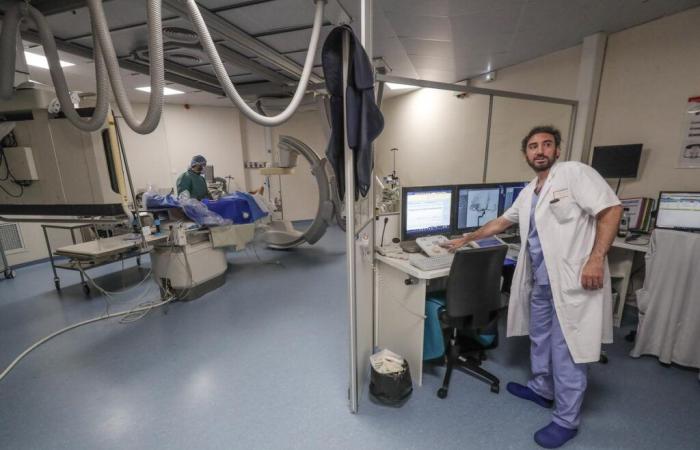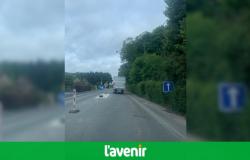UNot running against the clock, where every minute more is a question of life or death … that is to say that the new activity implemented since April at the Saint-Louis hospital in La Rochelle represents a major advance in the management of cerebral vascular accidents (stroke) in Charente-Maritime.
Transitional ischemic accident: what risk of long -term stroke?
Transient ischemic accidents (AI) occur when blood circulation is temporarily interrupted in the brain because of a clot that obstructs a vessel. Several symptoms can be a sign: numbness of the face, an arm or a leg (or loss of force), a temporary vision disorder of an eye or even speech disorders … These symptoms disappear in a few minutes but must be taken care of immediately because the risk of stroke (stroke) in the following days is high.
From now on, the victims in the acute phase will no longer have to be evacuated to the Center Hospitalier Universitaire (CHU) in Poitiers, distant by road from around 1 h 45 from La Rochelle, even more from Royan, Saintes or Oléron. Even transport by helicopter, the means most often used but not always available and dependent on weather conditions, is not better than a “house” device.
The saving of precious time was obtained at the price of five years of procedures by the Atlantic Littoral Hospital Group, in order to be authorized to practice brain mechanical thrombectomy. This technique consists in extracting, in the case of ischemic stroke (1), the clot obstructing an artery with a specific medical device, to restore blood circulation to the brain. It should be performed as quickly as possible, as soon as symptoms appear ideally, in less than six hours after the start of the stroke, up to 24 hours in certain cases “selected” by medical imaging. The practitioner passes a catheter in the artery, under local anesthesia as much as possible, to remove the clot.
A multidisciplinary course
Recommended by the High Authority for Health in 2016, mechanical thrombectomy was first implemented in the CHUs, then in large hospital centers, like those of Pau and Bayonne (Pyrénées-Atlantiques) in New Aquitaine. After the publication of the new decrees expanding this practice, La Rochelle made its request in spring 2024 and obtained the green light from the Regional Health Agency (ARS) in December. The mechanical thrombectomy center opened on March 31.
The hospital did not have to invest in the purchase of new tools. Everything was already there, or almost. Interventional neuroradiologists, the only ones authorized to perform acts. The X -ray machine which reveals the presence of an occlusion by a clot thanks to the injection of a contrast product. And even the room that hosts the activity.
-“It is a multidisciplinary course,” explains Gaëlle Godenèche, head of the neurology service, which includes the regulatory doctors of the center 15, the emergency physicians, the nurses, the stretchers, then the neurologists and the interventional neuroradiologists. There must be less than 20 minutes from the patient’s reception and his care in the thrombectomy room. »»
Only the authorization of the ARS was missing to complete the “AVC sector” of the hospital group, which has a neurovascular unit since 2009 (eight beds), where nearly a thousand patients are taken care of each year. The stakes are high in a department where people over the age of 65, who represent 75 % of stroke victims, reached almost 35 % of the population.
“The goal is to strengthen the territorial network,” emphasizes Yannick de la Torre, a neuroradiologist. Other so -called peripheral centers, apart from the CHUs, are open or during the opening. »»
(1) More than 80 % of cerebral vascular accidents. Hémorrhagic strokes are caused by the rupture of a vessel.
“I tell myself that I was lucky”: the testimony of the first patient
The life of Pierre Perrault almost changed on April 20. She only kept a telephone call, only the 75-year-old retiree, living alone in Périgny, himself passed.
“I fell around 5 pm. I got up but I had trouble walking. I also had trouble talking. I suspected a stroke but the symptoms disappeared fairly quickly. As it was Easter Sunday, I hesitated to call, which is obviously not to do. I called the firefighters at 6 p.m., who came very quickly. I went up alone in the ambulance, I was very good. Arriving in the emergency room, it started again and I had all the paralyzed left side. »»
First patient benefiting from a mechanical thrombectomy in La Rochelle, the perignacian, without serious history, in good health and with impeccable lifestyle, left the hospital three days later. Today he presents no sequelae. “Above all, do not trust to get better,” he warns. When I think myself that I should have gone to Poitiers a few weeks old, I tell myself that I was lucky. »»








